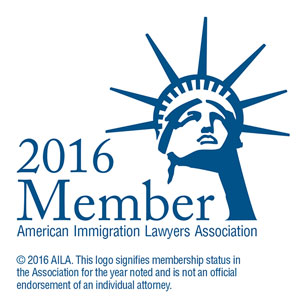Are We Trying to Penalize Failure to Serve in the Syrian Army? How Recent Changes to the Visa Waiver Program Go Too Far
Section 203 of Division O of the recently enacted Consolidated Appropriations Act, 2016, which funds the U.S. government for the remainder of the current 2016 fiscal year (through September 2016), also adds new restrictions on use of the Visa Waiver Program (“VWP”) that exists under section 217 of the Immigration and Nationality Act (INA), 8 U.S.C. §1187. The title of Section 203 is “RESTRICTION ON USE OF VISA WAIVER PROGRAM FOR ALIENS WHO TRAVEL TO CERTAIN COUNTRIES”, and it appears to have been inspired by reports that the November 2015 terrorist attacks in Paris were carried out by French and Belgian nationals, many of whom had traveled to Syria. However, the text of the law as enacted goes further than the title. In particular, the amendments that Section 203 makes to INA 217 apply to certain people who may never have been to any of the countries with which Congress was concerned in enacting the bill, if they are nationals of one of those countries as well as a VWP country. As this post will explain, this portion of Section 203 could have an unfair and at times truly bizarre impact.
The VWP allows citizens of certain countries designated by the Secretary of Homeland Security (formerly by the Attorney General), in consultation with the Secretary of State, to enter the United States as visitors without the need to apply for a visa at a U.S. consular post abroad. A list of currently eligible countries is available on the Department of State website and from CBP as well. VWP entrants are limited to 90-day admissions pursuant to INA §217(a)(1), must waive various rights to contest removal under INA §217(b), and must apply for advance clearance through the Electronic System for Travel Authorization (ESTA) run by U.S. Customs and Border Protection (CBP), but the ability to visit without going through the consular visa application process is still an attractive option for citizens of qualifying countries.
New section 217(a)(12) of the INA, as enacted by section 203 of Division O of the Consolidated Appropriations Act, 2016, adds the following requirements for use of the VWP:
(12) NOT PRESENT IN IRAQ, SYRIA, OR ANY OTHER COUNTRY OR AREA OF CONCERN.—
(A) IN GENERAL.—Except as provided in subparagraphs (B) and (C)—
(i) the alien has not been present, at any time on or after March 1, 2011—
(I) in Iraq or Syria;
(II) in a country that is designated by the Secretary of State under section 6(j) of the Export Administration Act of 1979 (50 U.S.C. 2405) (as continued in effect under the International Emergency Economic Powers Act (50 U.S.C. 1701 et seq.)), section 40 of the Arms Export Control Act (22 U.S.C. 2780), section 620A of the Foreign Assistance Act of 1961 (22 U.S.C. 2371), or any other provision of law, as a country, the government of which has repeatedly provided support of acts of international terrorism; or
(III) in any other country or area of concern designated by the Secretary of Homeland Security under subparagraph (D); and
(ii) regardless of whether the alien is a national of a program country, the alien is not a national of—
(I) Iraq or Syria;
(II) a country that is designated, at the time the alien applies for admission, by the Secretary of State under section 6(j) of the Export Administration Act of 1979 (50 U.S.C. 2405) (as continued in effect under the International Emergency Economic Powers Act (50 U.S.C. 1701 et seq.)), section 40 of the Arms Export Control Act (22 U.S.C. 2780), section 620A of the Foreign Assistance Act of 1961 (22 U.S.C. 2371), or any other provision of law, as a country, the government of which has repeatedly provided support of acts of international terrorism; or
(III) any other country that is designated, at the time the alien applies for admission, by the Secretary of Homeland Security under subparagraph (D).
(B) CERTAIN MILITARY PERSONNEL AND GOVERNMENT EMPLOYEES.—Subparagraph (A)(i) shall not apply in the
case of an alien if the Secretary of Homeland Security determines that the alien was present—
(i) in order to perform military service in the armed forces of a program country; or
(ii) in order to carry out official duties as a full time employee of the government of a program country.
(C) WAIVER.—The Secretary of Homeland Security may waive the application of subparagraph (A) to an alien if the Secretary determines that such a waiver is in the law enforcement or national security interests of the United States.
(D) COUNTRIES OR AREAS OF CONCERN.—
(i) IN GENERAL.—Not later than 60 days after the date of the enactment of this paragraph, the Secretary of Homeland Security, in consultation with the Secretary of State and the Director of National Intelligence, shall determine whether the requirement under subparagraph (A) shall apply to any other country or area.
(ii) CRITERIA.—In making a determination under clause (i), the Secretary shall consider—
(I) whether the presence of an alien in the country or area increases the likelihood that the alien is a credible threat to the national security of the United States;
(II) whether a foreign terrorist organization has a significant presence in the country or area;
and
(III) whether the country or area is a safe haven for terrorists.
Although INA §217(a)(12)(A)(i), consistent with the title of new INA §217(a)(12), bars use of the VWP only persons who have actually been present in Iraq or Syria or another country of concern, after March 1, 2011, other than as a government employee or military member of a VWP country, new §217(a)(12)(A)(ii) goes significantly further than that. Quite apart from whether someone was present in Syria, Iraq, or another covered country after March 2011 – or has ever been present there – they will be excluded from use of the VWP if, in addition to being a citizen of a VWP-qualifying country, they are also a national of Iraq, Syria, or another covered country. The only exception will be if a waiver is granted to a particular person under INA §217(a)(12)(C) on the basis that “such a waiver is in the law enforcement or national security interests of the United States”.
The other covered countries besides Iraq and Syria, pursuant to new INA 217(a)(12)(A)(i)(II)-(III) and (A)(ii)(II)-(III), include those designated as state sponsors of terrorism by the State Department under several named laws, as well as any countries the Secretary of Homeland Security may later designate under §217(a)(12)(D). The State Department’s list of designated state sponsors of terrorism currently includes Iran, Sudan, and Syria. Syria is already named in INA §217(a)(12)(A)(i)(I) and (A)(ii)(I), but the other two are not. So in total, new INA §217(a)(12)(A)(i) currently applies to nationals of Syria, Iraq, Iran, and Sudan.
According to the Refworld web service of the Office of the UN High Commissioner for Refugees (UNHCR), Article 3.A. of the Syrian nationality law provides that in addition to other sources of nationality, “Anyone born inside or outside the country to a Syrian Arab father” has Syrian nationality. Article 10 of that same law allows a Syrian Arab to forfeit Syrian nationality upon acquiring foreign nationality, but only “provided that a decree has been issued, based on his request and upon recommendation by the Minister [of the Interior], allowing him to abandon his nationality after having fulfilled all his duties and obligations towards the state.” Thus, it appears that one who is born to a Syrian father, and may never have been to Syria, cannot simply avoid or give up Syrian nationality because he no longer wants it, particularly if he has not “fulfilled all his duties and obligations towards the state.” It seems likely, particularly in light of the similar Iranian provision discussed below, that this requirement to have fulfilled one’s “duties and obligations towards the state” is a reference, at least in part, to military service obligations.
Iranian nationality law, as reported by Princeton University’s Iran Data Portal, similarly provides for automatic acquisition of nationality through one’s father and does not allow loss of nationality at will. Article 976, Section 2, of the law bestows Iranian nationality on “Those whose fathers are Iranians, regardless of whether they have been born in Iran or outside of Iran.” Pursuant to Article 988, Iranian nationality can only be abandoned by those who “have reached the full age of 25”, and then only if “the Council of Ministers has allowed their renunciation of their Iranian nationality”, they have undertaken to transfer all rights they possess or may inherit to land in Iran, and “they have completed their national military service.” Those born to Iranian fathers who are under 25, have not completed their military service, do not wish to give up land in Iran, or incur the displeasure of the Council of Ministers, are evidently stuck with their Iranian nationality whether they want it or not.
Iraqi nationality law as reported by Refworld is not quite as bad in this regard, but Article 10(I) of that law does require a written renunciation of one’s Iraqi nationality before even one who has acquired a foreign nationality will lose his or her Iraqi nationality. It is unclear how a child could meaningfully execute such a renunciation, and an adult who becomes a citizen of a Visa Waiver Program country may never have thought to do so, even if he or she had no intention of going back to Iraq and never did.
Sudanese nationality law, as reported by Refworld, makes it easier to give up nationality than in the case of Iran or Syria, but not as easy as in the case of Iraq. Section 4(1)(b)(i) includes among those who are Sudanese nationals anyone whose “father was born in Sudan.” Under Section 10(a), the President of Sudan “may decide to revoke Sudanese nationality from” anyone over the age of majority who is proven to have “made a declaration renouncing his Sudanese nationality”, but the President is specifically given the power to “reject such a declaration if it was made during any war which Sudan participated in.” The law does not clarify whether the President can simply “decide” not to revoke nationality from one who has made a declaration of renunciation even absent such a war.
Thus, many citizens of VWP countries who lack any continuing meaningful ties to a country of concern, or never had any such ties, may be affected by the prohibition of INA §217(a)(12)(A)(ii). Children born to a Syrian, Iraqi, Iranian, or Sudanese father, who are too young to have signed written statements giving up their citizenship, will be barred from the VWP. Adults who have lived their entire lives in VWP countries, but were born to Syrian or Iranian fathers, and could not give up their citizenship under Syrian or Iranian law because they did not fulfill their military service obligations to Syria or Iran, will be barred from using the VWP. This is a rather bizarre result, since one doubts that Congress would have wanted to penalize people for not serving in the Syrian or Iranian military, had the issue been thought through. Perhaps the Secretary of Homeland Security could issue some sort of collective waiver under §217(a)(12)(C), on the basis that it would be in the national security interests of the United States not to encourage service by nationals of VWP countries in the Syrian and Iranian militaries, but that would be a rather cumbersome way to deal with a problem that should not exist in the first place.
Lest this discussion of what one might call involuntary nationality be thought overly academic, it is worth noting that U.S. immigration law does recognize, in at least one other context, the possibility that a person can be penalized for the existence of a nationality which the U.S. government believes them to hold but which they have never sought to use. In Matter of B-R-, 26 I&N Dec. 119 (BIA 2013), an asylum applicant who had been born in Venezuela, and was a citizen of Venezuela, was denied asylum after the Department of Homeland Security (DHS) “submitted evidence that [he] was a citizen of Spain by birth, because his father was born in Spain and was a citizen of that country.” 26 I&N Dec. at 120. Since the applicant in Matter of B-R- did not contest on appeal that he was a citizen of Spain as found by the Immigration Judge, and since he had not argued that he had unsuccessfully attempted to avail himself of the protection of Spain, he was held to be ineligible for asylum because he lacked a fear of persecution in Spain. Matter of B-R-, 26 I&N Dec. at 122 It would seem, under the logic of Matter of B-R-, that INA §217(b)(12)(A)(ii) will apply equally to those who are citizens of Syria, Iraq, Iran, or Sudan solely because of the status of their fathers.
It is true that those barred from the VWP by their Syrian, Iraqi, Iranian or Sudanese dual nationality will not actually be barred from visiting the United States. Rather, persons barred from the VWP on account of their dual nationality will be able to apply for nonimmigrant B-1 or B-2 (or combined B-1/B-2) visas at a U.S. consular post, just like those who are not citizens of VWP countries. But to subject citizens of friendly nations to this additional hurdle solely because of their paternity and possibly failure to satisfy obligations to Syria or Iran, as §217(a)(12)(A)(i) in effect does in some cases, is inappropriate. People who were born in Belgium or France or the UK or some other VWP country and have never left, or have lived in a VWP country for decades and never traveled to a country of concern, should not be precluded from using the VWP because of who their fathers were.
Moreover, because visa waivers are often offered on a basis of reciprocity, INA §217(a)(12)(A)(ii) could have a mirror-image effect on innocent U.S. citizens with the requisite parentage. European Union regulations, for example, as pointed out by NIAC Action (the sister organization of the National Iranian American Council), already provide for the imposition of visa requirements on citizens of countries who have themselves imposed visa requirements on EU nationals. So it is possible that the restrictions imposed by U.S. law on citizens of VWP countries who have dual citizenship in a country of concern, and may be unable to get rid of it, could be imposed by EU countries on U.S. citizens who have such dual citizenship.
Before INA §217(a)(12)(A)(ii) and the rest of Section 203 of the Consolidated Appropriations Act became law, AILA warned against hastily enacting its language in the form of what was then H.R. 158 unless the bill were modified and clarified in a variety of respects (including the nationality provision and other aspects such as legitimate travel to the countries of concern by journalists and humanitarian workers and so on). It is unfortunate that Congress did not heed this warning. The statute should be amended, whether by this Congress or by a future Congress, so that it does not bar from the VWP nominal citizens of covered countries who have not recently been to those countries. Other changes to the language produced by the same rushed process that gave us the above-discussed absurd results, although outside the scope of this blog post, may also be warranted.




